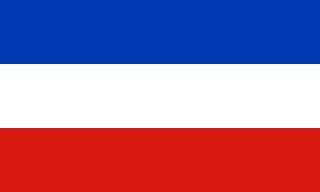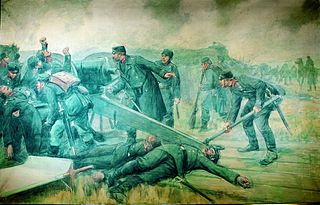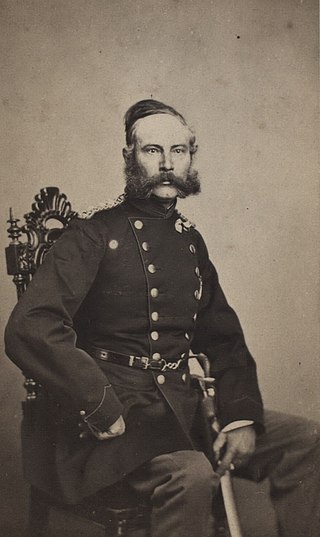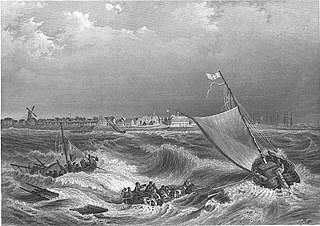
Schleswig-Holstein is the northernmost of the 16 states of Germany, comprising most of the historical Duchy of Holstein and the southern part of the former Duchy of Schleswig. Its capital city is Kiel; other notable cities are Lübeck and Flensburg. It covers an area of 15,763 km2 (6,086 sq mi), making it the 5th smallest German federal state by area. Historically, the name can also refer to a larger region, containing both present-day Schleswig-Holstein and the former South Jutland County in Denmark.

The First Schleswig War, also known as the Schleswig-Holstein Uprising and the Three Years' War, was a military conflict in southern Denmark and northern Germany rooted in the Schleswig-Holstein Question: who should control the Duchies of Schleswig, Holstein and Lauenburg, which at the time were ruled by the king of Denmark in a personal union. Ultimately, the Danish side proved victorious with the diplomatic support of the great powers, especially Britain and Russia, since the duchies were close to an important Baltic seaway connecting both powers.

The Second Schleswig War, also sometimes known as the Dano-Prussian War or Prusso-Danish War, was the second military conflict over the Schleswig-Holstein Question of the nineteenth century. The war began on 1 February 1864, when Prussian and Austrian forces crossed the border into the Danish fief Schleswig. Denmark fought troops of the Kingdom of Prussia and the Austrian Empire representing the German Confederation.

The Battle of Sehested was fought between Danish and Russian-Prussian-British troops at Sehested on 10 December 1813 during the War of the Sixth Coalition. The Danish Auxiliary Corps, which fought on the side of the French defeated the coalition forces commanded by Major General Ludwig von Wallmoden-Gimborn.

The Danish Life Regiment was an infantry regiment of the Royal Danish Army. On 1 January 2001 it was merged with the Zealand Life Regiment, into the Guard Hussar Regiment.

Olaf Rye was a Norwegian-Danish military officer. He died in battle during the First Schleswig War and is considered to have been a Danish war hero.

Triangle Region Denmark is a cooperation consisting of seven Danish municipalities on the Danish peninsula of Jutland and the island of Funen: Billund, Fredericia, Haderslev, Kolding, Middelfart, Vejen and Vejle.

The Schleswig Regiment of Foot is a Royal Danish Army infantry regiment. On 1 January 2001, the regiment was merged with the Queen's Life Regiment to form the Prince's Life Regiment. In 2018, it was announced that the regiment would be reestablished on 1 January 2019 as a light infantry battalion.

The Battle of Fredericia was fought between soldiers of Schleswig-Holstein and Denmark on 6 July 1849 at Fredericia in Denmark. The battle was a part of the First Schleswig War, which was a conflict between Schleswig-Holstein, supported by several German states, and Denmark. The Danes won the battle.

Jutland is a peninsula of Northern Europe that forms the continental portion of Denmark and part of northern Germany (Schleswig-Holstein). It stretches from the Grenen spit in the north to the confluence of the Elbe and the Sude in the southeast. The historic southern border river of Jutland as a cultural-geographical region, which historically also included Southern Schleswig, is the Eider. The peninsula, on the other hand, also comprises areas south of the Eider: Holstein, the former duchy of Lauenburg, and most of Hamburg and Lübeck.

The 10th Regiment was a Danish Army infantry regiment. On 1 September 1961 it was merged with 8. Regiment and from 1 November 1961 the new regiment was known as Dronningens Livregiment. The name Feltherrens Fodregiment was never the official name, as the official name was 10. Regiment.

The Battle of Mysunde on 2 February 1864 was the first battle between the Prusso-Austrian allied army and the Danish army in the Second Schleswig War. The Prussian vanguard force of 10,000 men attempted to break through and outflank the Danish defenses at Danevirke, but were repulsed by the fortification garrison and two battalions of the Danish army.

The Battle of Kolding was fought between a Prussian army under Eduard von Bonin and the Danish army under Frederik Rubeck Bülow in Eastern Jutland. The Prussians were victorious and the Danish army were forced to retreat towards Vejle and Fredericia.

Constituencies are used for elections to the Folketing, the national parliament of Denmark. Denmark proper is divided into 10 constituencies largely corresponding to the Provinces of Denmark, each electing multiple members using open-list proportional representation. Those constituencies are then divided into 92 opstillingskredse which mainly serve the purpose of nominating candidates, but historically functioned as single-member constituencies electing one member using plurality voting.

The Battle of Königshügel, also known as the Battle of Ober-Selk was a battle in the Second Schleswig War where Austrian Major General Gondrecourt and his infantry brigade succeeded in occupying the area in front of the Danevirke near Ober-Selk and taking the strategically important village of Königshügel.

Carl Philip Friedemann Maximilian Müller, more commonly known as Max Müller was a Danish officer who served in the First and Second Schleswig Wars.

The Evacuation of Fredericia was an event during the Second Schleswig War which began when Prussian and Austrian artillery shelled the fortress on March 20, 1864, with their artillery. When the Danish evacuated from the fortress which marked the end of Danish control of Jutland.

Cai Ditlev Hegermann-Lindencrone (1807-1893) was a Danish general and politician who was the main Danish commander at the Battle of Vejle during the Second Schleswig War as well as the personal adjutant general of Frederik VII. He was also the father of Johan Hegermann-Lindencrone and Fritz Hegermann-Lindencrone.

The capture of the North Frisian Islands and Rømø in July 1864 was the last military operation of the Second Schleswig War between Denmark on the one hand and Prussia and the Austrian Empire on the other hand around the duchies of Schleswig and Holstein, which belonged to Denmark. It ended with the occupation of the North Frisian Islands and Rømø by Austrian troops.

Hans Charles Johannes Beck was a Danish Colonel of the First Schleswig War and the Second Schleswig War. He was the main commander of the Battle of Lundby as well as a recipient of the Commander's Cross of the Order of the Dannebrog.
























